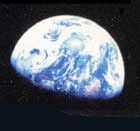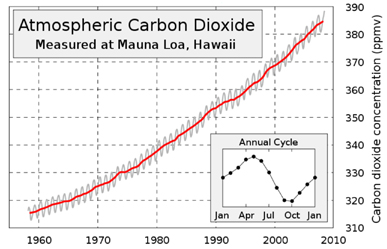Climate

some remarks on global heating and ocean acidity
|
Carbon dioxide amounts The natural, or pre-industrial, amount of carbon
dioxide in our atmosphere is about 280 ppm (parts per million).
The amount now is about 390 and is growing at an accelerating rate. There is a yearly oscillation in the graph,
of a few ppm, with blips in May and dips in October. This is because
there is more land, therefore more trees and other vegetation, in
earth's northern hemisphere; so the removal of carbon dioxide from
the air by leaves reaches a peak when the northern hemisphere's
foliage is thickest, then declines as that foliage withers and the
removal is carried on by the sothern hemisphere' lesser vegetation.
This “annual fluctuation” is insignificant compared with
the graph's overall upward climb. Though all the world's trees are
doing their best to absorb carbon dioxide, they cannot keep up with
our emission of it.
|

